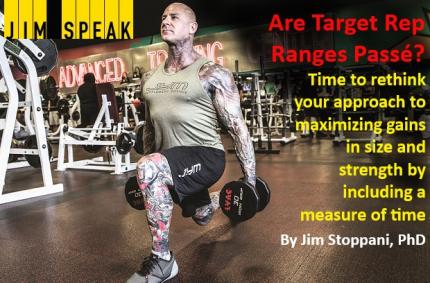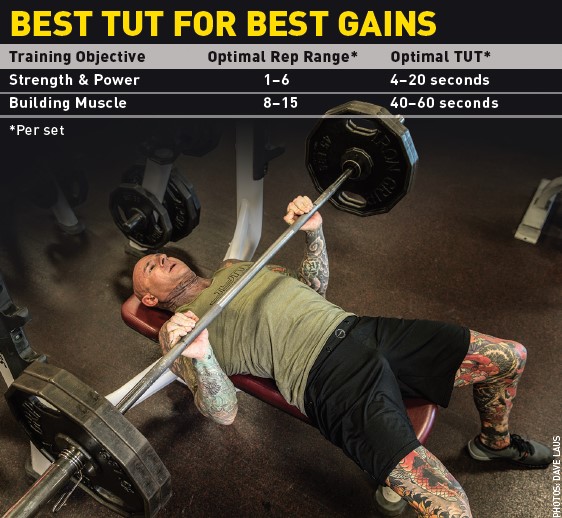Jim Talk

Jim Stoppani, PhD, earned a doctorate in exercise physiology with a minor in biochemistry from the University of Connecticut (Storrs) before serving as a postdoctoral research fellow at Yale University School of Medicine. In 2002, he was awarded the Gatorade Beginning Investigator in Exercise Science Award by the American Physiological Society for his groundbreaking research. For the next 10+ years, Dr. Stoppani served as Senior Science Editor for Muscle & Fitness, Muscle & Fitness Hers and FLEX magazines at Weider Publications. In 2013, he created his breakthrough sports nutrition company JYM Supplement Science, which now includes a line of eight top-selling products.

Target Rep Ranges
Time to rethink your approach to maximizing gains in size and strength by including a measure of time
We often think of our workouts as a collection of exercises with specific volume targets, including the number of sets, reps, and load. More specifically, when training to optimize muscle size, you choose a weight that enables you to reach about 8 to 15 reps; when it comes to strength, choose a load for just 1 to 6 reps.
After all this time, I’ve got some news for you: That approach isn’t entirely accurate. Say what? Choosing your rep target to achieve your stated goal isn’t the best way to go? What’s going on?
IF NOT REPS, THEN WHAT?
 In fact, those targets are good estimations of what you should be doing, but there’s another, more significant variable that’s often used instead of reps: It’s called time under tension, or TUT. Time under tension, in fact, appears to be a more important variable related to your specific goal, whether it’s size or strength. TUT represents the length of a set from start to finish, but you have to be careful of things such as locking out your joints, allowing a weight stack to touch down between reps, or otherwise briefly unloading the muscle, which can upset the actual TUT.
In fact, those targets are good estimations of what you should be doing, but there’s another, more significant variable that’s often used instead of reps: It’s called time under tension, or TUT. Time under tension, in fact, appears to be a more important variable related to your specific goal, whether it’s size or strength. TUT represents the length of a set from start to finish, but you have to be careful of things such as locking out your joints, allowing a weight stack to touch down between reps, or otherwise briefly unloading the muscle, which can upset the actual TUT.
TENSE SITUATION
TUT is an alternative way to measure a given set. Whereas most people define a set as how many reps were performed, TUT expresses it in terms of how long it took you to complete the set—in other words, how long (in seconds) your muscles were under the tension provided by the resistance you used (a barbell, dumbbells, cables, etc.).
For example, if you did a set of 8 reps, and each rep took you 4 seconds to complete (2 seconds on the positive, 2 seconds on the negative), your TUT for that set would be 32 seconds. A 15-rep set with the same rep speed would have a TUT of 60 seconds, and so on.
So which definition of a set—rep count or TUT—is better? Counting reps is obviously more common, not to mention more convenient, as keeping a tally in your head during a set is easier than trying to keep an eye on a stopwatch. So on sheer practicality, I’d say feel free to keep counting reps. That said, I also highly recommend monitoring your rep speed, which will determine your TUT for a given set. Because, in my opinion, the best way to ensure you’re maximizing your goal, be it size or strength, is to be in the sweet spot of both reps and TUT.
Here’s what we know: When it comes to TUT, those sweet spots appear to be 4 to 20 seconds for strength and power and 40 to 60 seconds for muscle size (hypertrophy).

SCRUTINIZING YOUR SETS
Now ask yourself, do your strength-building sets of 1 to 6 reps fall in the 4- to 20-second range? Chances are they do, since it only takes 1 or 2 reps to make a set last 4 sets, and most super heavy sets are impossible to continue for longer than 20 seconds. So the variables work pretty closely together there.
Where hypertrophy sets are concerned, this may be a different story. You may think you’re training for size, but if you fly through your 8-rep sets in only 20 to 30 seconds (1 to 2 seconds up, 1 to 2 seconds down on every rep), your TUT could be falling well short of the muscle-building sweet spot. And many folks using a relatively lighter weight go way too fast, completing their set in even less time!
My take-home advice here is simple: If you want to maximize muscle size, make sure your sets are falling in the 40- to 60-second TUT sweet spot, not just the 8- to 15-rep range. And if you’re partial to the low end of that range (say, sets of 8 to 10), keep your reps fairly slow and deliberate, or simply under control on all aspects of the lift, including the negative. If it takes you only 20 seconds to do 10 reps on dumbbell presses, you’re going too fast to optimize muscle building. Slow it down, even if you can push the weight faster.

Also, keep in mind that a set can fall outside of the 8- to 15-rep range but still be good for promoting hypertrophy; for example, a set of 5 super-slow reps, where rep speed is 5 seconds up, 5 seconds down (10 seconds per rep, 50 seconds TUT for the set). Likewise, a 20-rep set with faster reps (say, 3 seconds per rep for a TUT of 60 seconds) is perfectly acceptable, provided you control the negative on every rep.
As for strength, if you’re putting your true 1- to 6-rep-max (RM) on the bar, your rep speed will more or less take care of itself and probably fall in the 4- to 20-second range automatically. That’s because the heavy load negates any chance you can make to go as explosively under control; that is, there are no fast reps. Make sure you’re lowering the weight on the descent under control and pressing (or pulling) it with maximal force. Other than that, I wouldn’t advise slowing down or speeding up your reps when it comes to strength training.
 Get articles like this one delivered to your email each month by signing up for Muscle Insider’s mailing list. Just click here.
Get articles like this one delivered to your email each month by signing up for Muscle Insider’s mailing list. Just click here.

